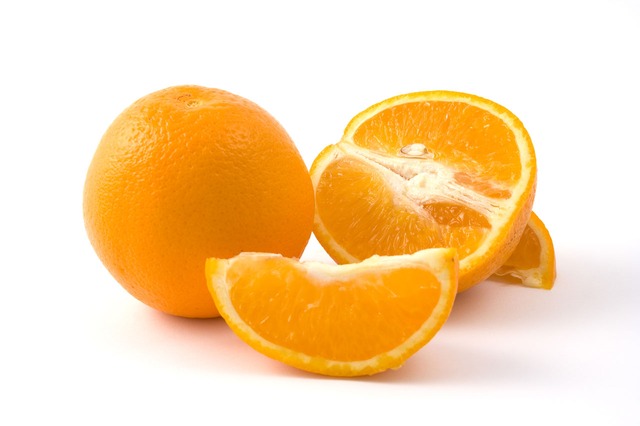| Fruits |
Vegetables
|
Orange, Citrus sinensis / Rutaceae
Benefits for the health

Fresh oranges are low in calories and a good source of fiber and potassium. Oranges are a rich vitamin C source. This vitamin is necessary to maintain gums, teeth and bones healthy, and for healing wounds. Vitamin C is a powerful antioxidant; it plays the role of intensifying the action of vitamin E and helps to the absorption of iron and the immunological functions. Oranges also contain great amounts of folate, a vitamin of the B complex that provides a useful protective effect during pregnancy.
In addition, oranges (and other related fruit) are a primary source of betacryptoxanthin in the diet. The betacryptoxanthin is a carotenoid provitamin A with antioxidant properties. They help to reduce the risk of cancer and cardiovascular diseases. All the citruses contain the flavonoid taxipholin, a phytochemical with antioxidant properties.
In addition, oranges (and other related fruit) are a primary source of betacryptoxanthin in the diet. The betacryptoxanthin is a carotenoid provitamin A with antioxidant properties. They help to reduce the risk of cancer and cardiovascular diseases. All the citruses contain the flavonoid taxipholin, a phytochemical with antioxidant properties.
Popular tradition
Oranges are very rich in mineral salts: potassium, calcium and phosphorus, vitamin A, C and B. They help to resist fatigue, they disinfect and favour fixing calcium. They act against diseases like rheumatism, gout, obesity and colds. It is very low in calories, only 44 calories for 100 grams, which makes them very recommendable for people that are on a diet.
Oranges are digestive and the infusions made of flowers and leaves are useful for dry cough, nerves, stomach ache and insomnia.
The orange is the second fruit that contains more vitamin B. The first position is occupied by tomatoes, followed by lemons. Vitamin B protects the nerves, increases the appetite and the digestive secretions, regulates the oxidations that take place in our cells and makes hydrocarbonated and fat foods profitable.
Another important vitamin in the orange is vitamin C, also called antiscorbutic, because the lack of it in our diet causes the scorbutic syndrome.
Oranges are also rich in fiber. The orange fiber causes a moderate reduction of the cholesterol levels, as tested in a research carried out on several people. They were given a fiber enriched diet (45,1 g/day), and a normal diet (21,2 g/day) as a control. Besides, the citric fibers lead to water retention, thus they are used in the industry for a wide range of foodstuffs, such as meat, sauces, or as yogurt and ice cream thickeners. They can even replace other ingredients like flour, fats or oils.
Oranges are also rich in flavonoids, that are secondary plant metabolites that have several properties like the antiallergic and antiinflammatory activity. In addition, some flavonoids have a certain anticarcinogenic activity since they maintain the cellular integrity and they help against cellular degeneration.
Another very important property of flavonoids is their antioxidant characteristic. In general, antioxidant compounds exert a protective effect by means of the inhibition of the oxidation reactions, that take place every day in our cells for their physiological activity. Thus, oxidation processes can damage the vascular walls of the blood vessels, accelerating diseases and leading to thrombosis.
We must remember that oranges should not be squeezed long before their consumption, since in contact with the air, vitamin C oxidizes and loses its properties. If the skin is used to garnish or cook, it is advisable to wash it with hot water and to rub it well, taking special care in getting rid of the small doses of protective substances that producers apply to them.
Oranges are digestive and the infusions made of flowers and leaves are useful for dry cough, nerves, stomach ache and insomnia.
The orange is the second fruit that contains more vitamin B. The first position is occupied by tomatoes, followed by lemons. Vitamin B protects the nerves, increases the appetite and the digestive secretions, regulates the oxidations that take place in our cells and makes hydrocarbonated and fat foods profitable.
Another important vitamin in the orange is vitamin C, also called antiscorbutic, because the lack of it in our diet causes the scorbutic syndrome.
Oranges are also rich in fiber. The orange fiber causes a moderate reduction of the cholesterol levels, as tested in a research carried out on several people. They were given a fiber enriched diet (45,1 g/day), and a normal diet (21,2 g/day) as a control. Besides, the citric fibers lead to water retention, thus they are used in the industry for a wide range of foodstuffs, such as meat, sauces, or as yogurt and ice cream thickeners. They can even replace other ingredients like flour, fats or oils.
Oranges are also rich in flavonoids, that are secondary plant metabolites that have several properties like the antiallergic and antiinflammatory activity. In addition, some flavonoids have a certain anticarcinogenic activity since they maintain the cellular integrity and they help against cellular degeneration.
Another very important property of flavonoids is their antioxidant characteristic. In general, antioxidant compounds exert a protective effect by means of the inhibition of the oxidation reactions, that take place every day in our cells for their physiological activity. Thus, oxidation processes can damage the vascular walls of the blood vessels, accelerating diseases and leading to thrombosis.
We must remember that oranges should not be squeezed long before their consumption, since in contact with the air, vitamin C oxidizes and loses its properties. If the skin is used to garnish or cook, it is advisable to wash it with hot water and to rub it well, taking special care in getting rid of the small doses of protective substances that producers apply to them.
| Interempresas Media, S.L. / 2026 | [ Legal notice | Política de Protección de Datos | Política de cookies | Publicidad] |
